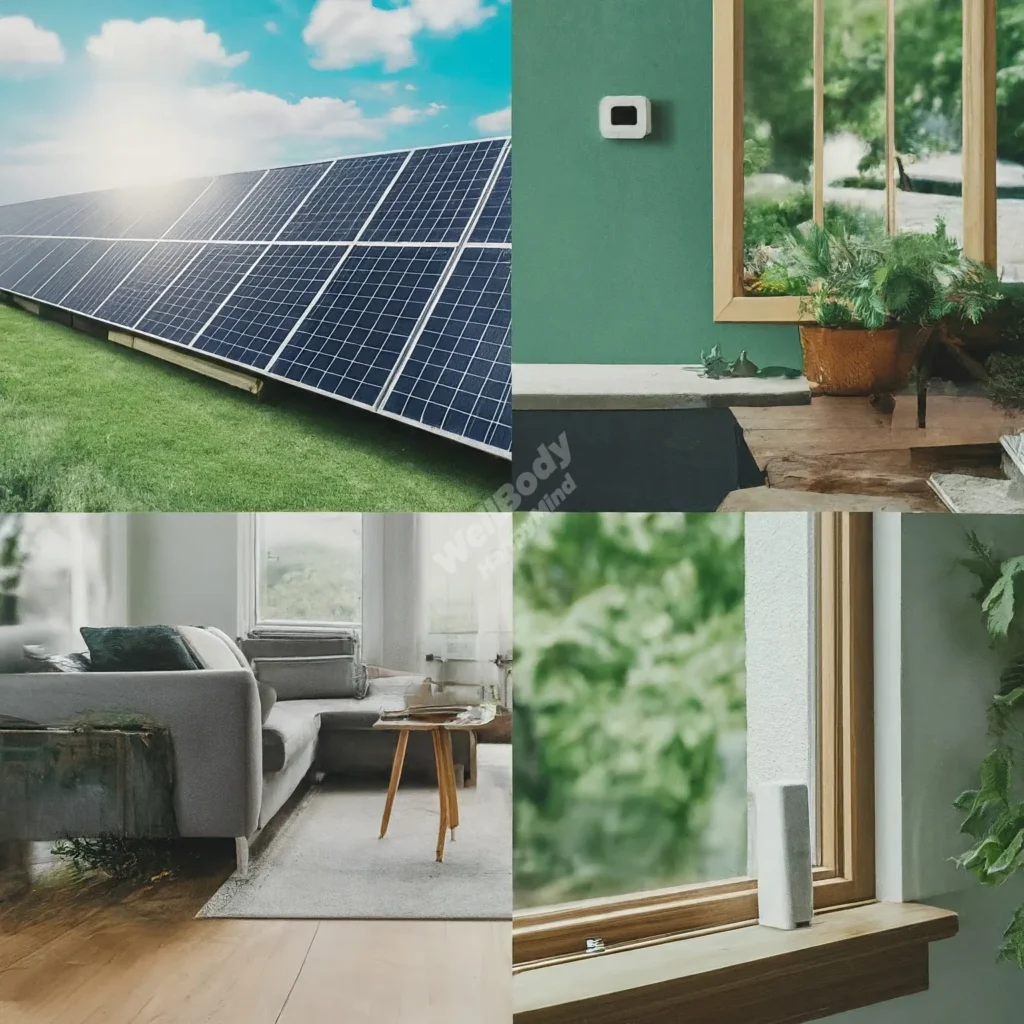Eco-Renovations: Smart Home Upgrades for a Greener Future

Introduction: Why Eco-Renovations Matter
Did you know that the average American home produces a whopping 5.5 tons of carbon dioxide each year? That’s like driving a car for 13,000 miles! But don’t worry – there’s good news.
Eco-renovations can help you slash this number. These are home improvements that put the Earth first. They’re not just good for the planet – they’re great for your wallet too!
What Are Eco-Renovations?
Eco-renovations, also called green home upgrades, are changes you make to your home that help the environment. They’re becoming more and more popular, and for good reason.
Benefits of Eco-Friendly Home Improvements
- Lower energy bills: You’ll save money every month.
- Higher home value: Your property becomes more attractive to buyers.
- Better air quality: Breathe easier in your own home.
- Reduced carbon footprint: Help fight climate change from your living room.
By making these changes, you’re not just helping the Earth – you’re helping yourself too. It’s a win-win!

Why Choose Eco-Friendly Home Improvements?
Making your home more eco-friendly isn’t just a trend – it’s a smart choice for many reasons. Let’s explore why you might want to consider green home upgrades.
1. Environmental Benefits
Reducing your carbon footprint is a big deal. Here’s how eco-renovations help:
- Less energy use: Efficient appliances and better insulation mean less power consumption.
- Fewer resources wasted: Sustainable materials last longer and often use recycled content.
- Lower water usage: Water-saving fixtures help conserve this precious resource.
2. Financial Advantages
Going green can put more green in your wallet:
- Lower utility bills: Energy-efficient upgrades can cut your monthly costs significantly.
- Tax incentives: Many governments offer tax breaks for eco-friendly home improvements.
- Increased home value: Green homes often sell for more and faster than standard homes.
3. Health Benefits
Your home should be a healthy place to live:
- Improved indoor air quality: Eco-friendly materials often release fewer harmful chemicals.
- Better temperature control: Proper insulation keeps your home comfortable year-round.
- Reduced allergens: Some green materials are naturally resistant to mold and pests.
4. Long-Term Sustainability
Think of eco-renovations as an investment in the future:
- Durability: Many sustainable materials last longer than traditional options.
- Adaptability: Green homes are often designed to be more flexible for future needs.
- Future-proofing: As environmental regulations tighten, your home will already be compliant.
By choosing eco-friendly home improvements, you’re not just making a house – you’re creating a sustainable living space that benefits you, your family, and the planet.
Top Eco-Friendly Home Renovation Ideas
Ready to make your home greener? Here are some of the best eco-friendly renovation ideas to consider:
1. Energy-Efficient Windows and Doors
Good insulation is key to an eco-friendly home. Here’s why windows and doors matter:
- Double-pane windows: These trap air between two layers of glass, reducing heat transfer.
- Low-E coatings: These special coatings reflect heat, keeping your home cooler in summer and warmer in winter.
- Weather-stripping: This simple addition to doors can significantly reduce drafts.
Benefits: Lower energy bills, improved comfort, and reduced outside noise.
2. Sustainable Flooring Options
Your choice of flooring can make a big difference. Consider these eco-friendly options:
- Bamboo: Fast-growing and durable.
- Cork: Naturally antimicrobial and sound-absorbing.
- Reclaimed wood: Gives new life to old materials.
Pro tip: Look for flooring certified by the Forest Stewardship Council (FSC) for assurance of sustainability.
3. Solar Panel Installation
Harness the power of the sun with solar panels:
- Grid-tied systems: Connect to the power grid and potentially sell excess energy back.
- Off-grid systems: Great for remote locations or those seeking energy independence.
- Hybrid systems: Offer the best of both worlds.
Important: Check your roof’s condition, sun exposure, and local regulations before installation.
4. Smart Home Technology
Make your home work smarter, not harder:
- Smart thermostats: Learn your habits and adjust temperature automatically.
- LED lighting systems: Use less energy and last longer than traditional bulbs.
- Smart power strips: Cut power to devices when not in use, reducing “vampire” energy drain.
Bonus: Many smart home devices can be controlled from your phone, making energy management easy and convenient.

5. Eco-Friendly Insulation
Proper insulation is crucial for energy efficiency. Here are some green options:
- Recycled denim: Made from old jeans, it’s effective and non-toxic.
- Cellulose: Created from recycled paper products, it’s affordable and fire-resistant.
- Sheep’s wool: Natural, renewable, and excellent at moisture management.
Key areas to insulate: Attic, walls, and floors for maximum impact.
6. Water-Saving Fixtures and Appliances
Conserve water with these eco-friendly upgrades:
- Low-flow toilets: Use up to 60% less water per flush.
- Water-efficient showerheads: Save water without sacrificing pressure.
- ENERGY STAR appliances: Look for this label on dishwashers and washing machines.
Bonus idea: Consider installing a greywater system to reuse water from sinks and showers for irrigation.
7. Sustainable Landscaping
Your yard can be eco-friendly too:
- Native plants: Require less water and maintenance.
- Permeable paving: Allows rainwater to soak into the ground, reducing runoff.
- Composting: Turn kitchen scraps into nutrient-rich soil for your garden.
Pro tip: Install a rain barrel to collect rainwater for watering your plants.
These eco-friendly home renovation ideas can significantly reduce your environmental impact while improving your home’s efficiency and comfort. Remember, you don’t have to do everything at once – even small changes can make a big difference over time.

Planning Your Eco-Renovation Project
Turning your home into an eco-friendly haven doesn’t happen overnight. It requires careful planning. Here’s how to get started:
Step 1: Assess Your Home’s Current Efficiency
Before making changes, understand where you’re starting from:
- Energy audit: A professional can identify areas where your home is losing energy.
- Water usage analysis: Check your water bills and habits to spot areas for improvement.
- Indoor air quality test: This can reveal if you need better ventilation or air filtration.
Step 2: Set Priorities and Create a Budget
Not all eco-renovations are created equal:
- List your goals: Do you want to reduce energy bills, use less water, or improve air quality?
- Rank improvements: Which changes will have the biggest impact?
- Set a realistic budget: Remember, many eco-upgrades pay for themselves over time.
Step 3: Find Eco-Friendly Contractors and Suppliers
Look for professionals who specialize in green building:
- Check certifications: Look for contractors certified in green building practices.
- Ask for references: Talk to past clients about their eco-renovation experiences.
- Research materials: Find suppliers who offer sustainable, non-toxic products.
Step 4: Create a Timeline
Rome wasn’t built in a day, and neither is an eco-friendly home:
- Start small: Begin with easier projects like changing light bulbs or installing a smart thermostat.
- Plan for disruptions: Some renovations might temporarily disrupt your daily life.
- Consider seasons: Some projects, like installing solar panels, might be better in certain seasons.
Step 5: Stay Flexible
Be prepared to adjust your plans:
- New technologies: The eco-friendly market is always evolving. Stay open to new options.
- Unexpected issues: Be ready to tackle unforeseen problems that might arise during renovations.
- Changing priorities: As you learn more, you might decide to shift your focus.
Remember, planning is key to a successful eco-renovation. Take your time, do your research, and don’t be afraid to ask for help from professionals.
Financing Your Eco-Renovation
Eco-friendly home improvements can be a smart investment, but they often require upfront costs. Here’s how you can finance your green upgrades:
Green Home Improvement Loans
Many lenders offer special loans for eco-renovations:
- Energy-efficient mortgages (EEMs): These allow you to finance energy-saving upgrades as part of your home mortgage.
- Home equity loans: Borrow against your home’s value to fund improvements.
- Personal loans: Some lenders offer lower rates for eco-friendly projects.
Tip: Compare interest rates and terms from multiple lenders before deciding.
Government Incentives and Tax Credits
Your eco-renovation might qualify for financial perks:
- Federal tax credits: Available for solar installations, energy-efficient windows, and more.
- State incentives: Many states offer additional rebates or tax breaks for green upgrades.
- Local programs: Some cities and counties have their own eco-friendly incentives.
Remember: These programs change often, so check the latest information before starting your project.
Calculating Long-Term Savings
Think beyond the initial cost:
- Energy savings: Estimate how much you’ll save on utility bills each month.
- Water conservation: Calculate potential savings from reduced water usage.
- Increased home value: Green upgrades can boost your property’s resale value.
Pro tip: Use online calculators to estimate your potential savings over time.
Creative Financing Options
Think outside the box:
- Power purchase agreements (PPAs): For solar installations, some companies will install panels for free and sell you the power at a reduced rate.
- Energy-saving performance contracts: Some contractors will finance your upgrades and get paid from the energy savings.
- Crowdfunding: For community projects, consider platforms like GoFundMe or Indiegogo.
Plan for the Long Haul
Remember, eco-renovations are an investment:
- Prioritize projects: Start with upgrades that offer the quickest return on investment.
- Track your savings: Monitor your bills to see the real impact of your improvements.
- Reinvest savings: Use the money you save on bills to fund future eco-projects.
By exploring these financing options, you can make your eco-renovation dreams a reality without breaking the bank. Remember, the money you invest today can lead to significant savings and a smaller carbon footprint in the future.
Conclusion
Embarking on an eco-renovation journey is more than just a home improvement project – it’s a step towards a more sustainable future. Let’s recap the key points we’ve covered:
- Eco-friendly home improvements offer multiple benefits: they reduce your environmental impact, lower your utility bills, and can increase your home’s value.
- From energy-efficient windows to solar panels, there are numerous ways to make your home greener.
- Proper planning and financing are crucial for a successful eco-renovation project.
Remember, you don’t have to transform your home overnight. Start small and gradually implement changes as your budget and time allow. Even minor adjustments, like switching to LED bulbs or installing a smart thermostat, can make a significant difference over time.
By choosing to renovate with the Earth in mind, you’re not just improving your living space – you’re contributing to a larger movement towards sustainability. Your actions, combined with those of others, can have a real impact on our planet’s health.
So, are you ready to take the first step towards a greener home? Whether it’s researching energy-efficient appliances or scheduling an energy audit, every action counts. Your future self – and the planet – will thank you for the positive changes you make today.
Remember, a more sustainable home isn’t just good for the environment – it’s good for you too. Enjoy the journey to a greener, more efficient, and more comfortable living space!



